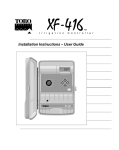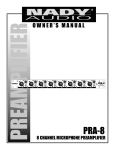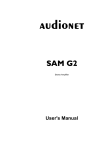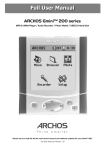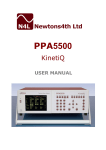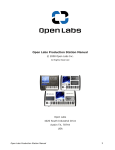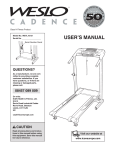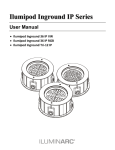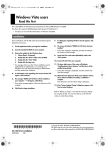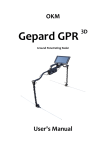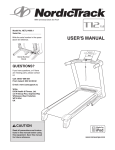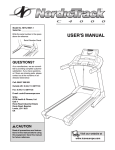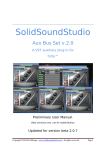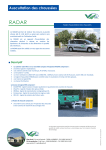Download Macintosh User`s Guide
Transcript
Macintosh User's Guide TM Professional 24-bit Digital Recording Interface Gadget Labs Software License Agreement The software programs included with this product (the "Software") are owned or licensed by Gadget Labs, Inc. and are protected by United States and international copyright laws and international trade provisions. All rights are reserved. The purchaser is granted a license to use the software only, subject to the following restrictions and limitations. License Gadget Labs grants you rights to use the Software on a single user computer, or on a single terminal or workstation of a multi-user computer or local area network. A separate license must be obtained from Gadget Labs for every other terminal or workstation on a multi-user computer or local area network. Copy restrictions A. This Software and the accompanying written materials are copyrighted and are proprietary products of Gadget Labs. You may make one copy of the Software for backup or archival purposes. All other copying of the Software or written materials is expressly forbidden. B. You may not decompile, reverse engineer, copy, transfer, make telecommunications data transmissions of the Software or otherwise use the Software except as expressly stated in this Agreement. Termination This license is effective until terminated. You may terminate this license at any time by destroying all copies of the Software. This license will terminate automatically, without notice from Gadget Labs, if you fail to comply with this Agreement. Upon such termination, you shall destroy all copies of the Software (together with all modifications and merged portions in any form). Limited warranty A. Gadget Labs warrants that the original disks are free from defects in material and workmanship, assuming normal use, for a period of ninety (90) days from the date of purchase. If a defect occurs during this time, you may return your faulty disk to Gadget Labs, along with a dated proof of purchase, and it will be replaced free of charge. B. Except for the express warranty set forth above, Gadget Labs grants no other warranties express or implied, regarding the disks and documentation, their fitness for a particular purpose, their quality or their merchantability. No oral or written information or advice given by Gadget Labs, its reseller, agents, or employees shall create a warranty. Some states do not allow the exclusion or limitation of implied warranties, so the above exclusions and/or limitations may not apply to you. C. Gadget Labs' entire liability and your exclusive remedy shall be the replacement of the Software that does not meet Gadget Labs' limited warranty and that is returned to Gadget Labs with a dated proof of purchase. No liability for consequential damages In no event shall Gadget Labs be liable for any damages, including any loss of profits, or other incidental or consequential damages, arising out of your use or inability to use the Software or written materials, even if Gadget Labs has been advised of the possibility of such damages. Some states do not allow the exclusion or limitation of liability for consequential damages or incidental damages, so the above exclusions and/or limitations may not apply to you. Miscellaneous This Agreement is governed by the laws of the State of Oregon in the United States. If any provision of this Agreement shall be unlawful, void, or for any reason unenforceable, then that provision shall be deemed severed from this Agreement and shall not affect the validity or enforceability of the remaining provisions of this Agreement. Trademarks WavePRO, Wave/424, Wave/496, Wave/824, SoundCache and Gadget Labs are trademarks of Gadget Labs, Inc. Other names are trademarks or registered trademarks and are property of their respective owners. i TM Digital Recording Interface Macintosh User's Guide First things first! Thank you for purchasing your WavePRO digital recording interface. We "gadgeteers" genuinely appreciate your patronage. This guide contains information on installing and using the interface, and we tried to make it as brief as possible (because no one has time to read manuals anyway). If you have ideas about how we can improve our products, we'd like to hear from you. Our contact information is on the back cover of this manual. Also, if you have any difficulty installing or using the WavePRO interface, please refer to the Support section of this guide. Our goals When we designed the WavePRO family, our primary focus was to create a professional recording tool with a straight-forward design that's easy to use. Our emphasis is on bringing you the very best combination of quality and value. To that end, we didn't clutter the product with lots of features that might be confusing or get in the way of the primary reason you bought this thing in the first place: to make great music & audio recordings! Thanks again and Have Fun! TABLE OF CONTENTS Getting started ....................................................................2 Installing the WavePRO hardware and software drivers ...................2 Connecting the WavePRO interface to your music studio system ........9 Advanced Configuration: WavePRO Control Panel Applet .............. 11 Setting up applications for the WavePRO interface ...................... 14 Specific application configuration ........................................... 15 A few basic tips about multi-track audio recording with you PC ...... 18 Troubleshooting ................................................................. 19 Registration, Support & Warranty information ............................ 20 FCC and other compliance stuff ............................................. 21 1 GETTING STARTED Here’s a list of stuff that’s included with this package: Wave/824 Wave/496 Wave/424 WavePRO PCI card ü ü ü Computer interface cable (6 feet / 2 meters) ü ü ü ü MIDI adapter cable Patch Box: 4 in, 4 out half-rack ü ü ü Patch Box: 8 in, 8 out rack-mount AC Power Cube 4 Rubber feet for bottom of Patch Box. For placing patch box on a desktop instead of equipment rack. WavePRO software drivers diskette User’s Guide (duh) ü ü ü ü ü ü ü ü INSTALLING THE WAVEPRO HARDWARE & SOFTWARE DRIVERS WavePRO interfaces are designed to be truly Plug and Play. Installation in most systems should take only a few minutes. If you have any difficulties with installation or operation of WavePRO, check the Troubleshooting section later in this guide. STEP Œ Shut down and turn off your Mac Before you begin installing your WavePRO interface please note: Static electricity can damage electronic components! Take the following precaution before you begin installation: Shut down and turn off the Mac but leave it plugged in. Touch the metal chassis of the Mac to drain the static from your bod J before you touch the WavePRO PCI card. Next, unplug the Mac's power cable. Follow the steps in your Mac's user manual and remove the Mac chassis cover. 2 STEP • Install the WavePRO PCI card Select a PCI slot in your computer that has enough clearance for the WavePRO card. The WavePRO cards have been specially designed to be extremely immune to noise generated by other components in your Mac. n Be careful to avoid damaging any components and plug the WavePRO PCI card into the slot. n Make sure the card fits securely and then replace the PCI card’s mounting screw. n Reinstall the Mac's chassis cover n DO NOT TURN ON THE COMPUTER YET WavePRO PCI card connections Wave/824 Wave/496 Wave/424 Line INPUTS 1 & 2 25-pin connector for cable to Patch box Line INPUTS 3 & 4 Line OUTPUTS 1 & 2 Line OUTPUTS 3 & 4 IN RCA jacks OUT Purcell, CA P108-000 for SP DIF digital I/O option (not included with basic Wave/824 interface) 9-pin connector for MIDI cable adapter 3 IF YOU ARE INSTALLING THE WAVE/824 OR WAVE/496, FOLLOW THE NEXT STEP. (note: if you are installing the Wave/424, go to Step 6) STEP Ž Connect the PCI card to the Patch Box Connect one end of the Computer Interface Cable to the WavePRO PCI card connection at the back of the computer. Connect the other end of the Computer Interface Cable to the back of the Patch Box. For the Wave/824, you can also connect MIDI cables to the MIDI IN & OUT connections. IF YOU ARE INSTALLING THE WAVE/824, FOLLOW THE NEXT STEPS 4 and 5 (note: if you are installing the Wave/496 or Wave/424, go to Step 6) STEP • Connect the cord from the AC Power Cube to the Patch Box Plug the small connector on the end of the cable from the Power Cube to the Wave/824. Make sure this connection is secure since the Wave/824 must have power to operate properly. If you won't be using the Wave/824 in an equipment rack, you should also stick the rubber feet on the bottom of the Patch Box. 4 STEP • Connect the Power Cube to an AC outlet Connect the Power Cube to an AC power outlet. This can be directly into a wall outlet or a power strip. When this power is on, the green light on the front of the Wave/824 will turn on. The Patch Box does not have a power on/off switch and it's OK to leave it powered on or off when not in use. STEP ‘ INSTALLING THE SOFTWARE DRIVERS After installing the WavePRO hardware, reconnect the computer's power cord, turn on the power switch and boot your computer. n Once your Mac is booted up, insert the diskette labeled ‘WavePRO Macintosh Drivers’. n Note: If your Mac does not have a floppy disk drive, please surf to our Internet Web site to download the drivers. The URL address is: http://www.gadgetlabs.com/support/downloads.htm The software diskette includes unique Installer files for each WavePRO product. For example, there is a file called, ‘Wave/824 Macintosh Installer’ and also one called, ‘Wave/424 Macintosh Installer’. The Installer files include software drivers that support both Audio (the ASIO driver) and for MIDI (the OMS ‘Open Music System’ driver). n To start the driver installation, double-click the Installer icon that corresponds to your WavePRO product. You will see the End User License Agreement, please read through this before hitting the Continue button. n After hitting Continue, the installer will prompt you for a location. Select a location (remember where it was!), and hit the Install button. n The Installer will now copy the necessary files onto your hard disk. 5 n Below is a list of the files, and where they are installed (*** = the particular WavePRO product number): Wave/*** Control Panel à Control Panels folder Wave/*** Library à Extensions folder Wave/*** ASIO à Folder you selected Wave/*** OMS Driver à Folder you selected README 1ST à Folder you selected Setting up the Audio ASIO driver After the software is installed, for each application you wish to use with the Wave/824, you will need to copy the Wave824 ASIO file into that application's ASIO Driver folder. In other words, if you don't copy the Wave824 ASIO driver into an applications ASIO folder, you will not be able to use the Wave/824 with the application. If you have multiple audio applications that support ASIO, you will, of course, have multiple copies of the Wave824 ASIO file in your system. Setting up the MIDI OMS driver n OMS Client Application setup: The OMS MIDI system has two parts, the OMS client application and the hardware driver. If you have already installed your MIDI sequencing software (eg. Cubase VST or Digital Performer), the OMS client application may already be installed. If not, you'll need to download the OMS client application from Opcode's website, located at: http://www.opcode.com/dl/oms/oms_mac.html (as of this document, the latest version of OMS was 2.3.8). After downloading OMS, run the installer to install the Open Music System on your computer. The OMS installer will ask you to reboot, please do so. n After rebooting, you will need to copy the Wave/*** OMS Driver file into the OMS Folder, located in your System folder. n Once the Wave/*** OMS Driver file is in the OMS Folder, run the OMS Setup Application, located in the Opcode: OMS Applications folder on your computer's hard disk. 6 n OMS Setup will walk you thru creating a new Studio setup. During the auto detection, it will show the Wave/*** Device, and list any MIDI devices it finds currently attached (keyboards, tone generators, etc...). n After the OMS Setup has finished, start your audio application. In that application’s MIDI setup, make sure that OMS Functionality is set for IN/OUT. n Please consult your software application and hardware documentation for instructions on setting up your other MIDI devices (keyboards, tone generators, etc...) for use with OMS. 7 8 Rear panel For connection convenience, the first 2 audio channels have both 1/4" (6.35 mm) jacks and professional XLR jacks. Tip Sleeve Unbalanced plug wiring Tip Ring Sleeve Balanced TRS plug wiring Tip Tip Ring Tip = + (hot) Sleeve = ground Tip = + (hot) Ring = - (cold) Sleeve = ground The audio connections for the Wave/824 are very versatile. They are LINE-LEVEL which means that you will need to preamplify any microphone or low-level signal prior to connection. Almost any type of analog audio line-level signal can be connected to the Wave/824. This includes both balanced (3-wire) and unbalanced (2-wire). Additionally, the strength of the input or output signal can be switched to either the professional standard of +4 dBu (louder) or the consumer audio standard of -10 dBV (about 12 dB softer). The Control Panel software applet is used to switch signal levels. Wave/824 Audio connections CONNECTING A WAVEPRO INTERFACE TO YOUR MUSIC STUDIO SYSTEM The WavePRO interfaces are designed to work seamlessly within your music recording system in a fashion similar to a traditional multi-track recorder. Typically, major components of the recording system are: n n n n n multi-channel audio mixer console microphones and preamplifiers effects processors such as limiters, noise gates, reverb units multi-channel audio recorder power amplifier and monitor speakers OV7 NOTE: Microphones do not have enough signal strength and must be amplified by a mixer or preamplifier prior to connecting to WavePRO. Inside the PC WavePRO Audio cables Audio Mixer CD-R drive MIDI cables Synth Sound Module Effects Processors Amp & Monitor Mastering Tape Recorder (DAT, cassette, reel) At the heart of the system is the mixer whose inputs and outputs are connected to all the other pieces of equipment. The mixer is the router or traffic cop and it connects signals together and controls volume levels and equalization. Thus, the mixer is an essential part of the system and it's often built-in to mini-studio products such as multi-track cassette recorders. In a professional environment, the mixer is always a separate piece of equipment. The mixer and the sound card Typical low cost multimedia sound cards or a computer’s built-in audio are not designed for multi-channel recording. They usually include a low-quality, integrated mixer that controls the volume of stereo audio streams from wave file output, music synthesizer and CD-audio player that are produced by games and applications. When you get started with serious music recording on your Mac, it's important to recognize that achieving the full benefits of multiple channels requires using an external audio mixer to route and mix the channels down to two channel stereo. 9 Why isn't there extra mixer circuitry included with the WavePRO interfaces? When we designed WavePRO, we concluded that having a built-in mixer would make it more complicated to use the card in conjunction with an external mixer. Also, when extra mixer circuitry is included in an audio card, an extra level of amplification is required. This can diminish audio quality and add noise. We decided to avoid needless complexity and preserve the highest audio quality. Since the WavePRO interface requires a line level signal, you will need to make sure that any low-level signals, such as microphones, are preamplified. Connecting a WavePRO interface to an audio mixer console Below is a block diagram for connecting a WavePRO interface to a mixer. A wide variety of mixers is are available from many different manufacturers. If you are considering the purchase of a mixer for your recording setup, you can buy small consoles with prices that start at around $300 US. We recommend that you use a mixer that has channel inserts (also called patch points). For quietest operation, we recommend that you directly patch the WavePRO inputs to the channel inserts jacks. This offers maximum mixing flexibility. Connections for WavePRO to mixer with Channel Insert Jacks Example: mixer channel insert connection Mono plug TO WavePRO INPUTS 1 2 3 4 5 M I X Mixer Input E channels R Insert plug to first click of channel insert jack etc. Channel insert jacks 1 2 3 4 5 6 7 8 9 10 11 12 13 Microphones FROM WavePRO Guitar rig OUTPUTS Keyboards, etc. 10 Mixer outputs Connect to monitor amp, DAT, etc. ADVANCED CONFIGURATION: WavePRO Control Panel We've included a control panel software applet to select the input and output levels of the WavePRO interfaces and control other features. To start the WavePRO applet, select 'Start | Settings | Control Panel' and double click on the 'WavePRO' icon. For quick access, the applet can also reside Windows system tray. This feature is enabled under the Options menu. Input and Output Gain Settings The settings for input and output sensitivity are unique to the different Wave/PRO models. On the Wave/424, the input and output levels are set to the popular semi-pro levels (-10 dBV nominal). If audio being input to the Wave/424 is overloading the inputs and causing distortion, enable the Input Pad settings by checking the box next to the appropriate channel Note: Use Input Pad settings to connect with pro equipment that uses +4 dBu levels. The Wave/824 and Wave/496 are designed to connect to virtually any preamplified, line-level audio signal. The connection can be 3conductor, balanced or 2-conductor, unbalanced. Additionally, the signal level can be professional +4dBu (higher, i.e. "louder") or 10dBV, the standard for consumer audio equipment. The Control Panel applet switches whether an input or output level is set to +4 or -10. The facilitation of either Balanced or Unbalanced signals is automatic. 11 These settings help you match the signal level (sensitivity and loudness) of the audio inputs and outputs of the Wave/824. The difference in the 2 levels is about 12 dB. Inputs: -10 dBV setting is more sensitive than the +4 dBu setting. Outputs: +4 dBu output is louder than the -10 dBV setting. TIP: by default, the gain levels are set to -10 dBV. This is most common setting for music and audio gear. It's best to try out this setting first and then, change the levels to +4 dBu if you need more output gain from the Wave/824 or Wave/496. TIP: If you are experiencing overloading on the audio inputs, change the setting to +4 dBu to decrease the input sensitivity. Setting Input and Output Gain on Wave/824 & Wave/496 12 Monitor (Input monitor) Unlike a tape recorder, WavePRO interfaces are full duplex audio devices which means that you can record and play on all channels simultaneously. We have also included an input monitoring feature that allows the audio signal that is being input to WavePRO to be "echoed" to the corresponding channel number output. Important note When Monitoring is enabled (ON) you will hear both the signal that is being input to the WavePRO interface for recording and the audio playback signal from the WavePRO interface. As noted in the diagram, when monitoring, each input channel is monitored to its corresponding output channel. Normal operation (Monitor off) Input channel 1 Audio to PC Audio from PC Output channel 1 Monitor ON Input channel 1 Audio to PC Output channel 1 Audio from PC 13 SETTING UP SOFTWARE APPLICATIONS FOR WAVEPRO To most audio software applications,the WavePRO interfaces appear as multiple, stereo sound card devices. To use a WavePRO interface with your software, its inputs and outputs must be selected as the active devices. The steps to accomplish this vary from application to application. Refer to your software's user manual to establish the WavePRO interface as the active audio device and to change audio the audio settings and configuration. Typically, there is a menu item in the application which brings up a dialog box that’s used to select and setup devices. A list of available audio or MIDI devices is displayed and you select the active devices. An additional step of selecting the device for a specific track is often required. You will also need to enable the 24-bit mode. WavePRO interfaces also support 16-bit mode for compatibility with all applications. Once WavePRO is installed, the following devices will be found. NOTE: In these setup tips, the characters, *** indicate your specific WavePRO model number 424, 496, and 824) n Ch 1/2 In Wave/*** first, stereo wave audio input n Ch 3/4 In Wave/*** second, stereo wave audio input n Ch 1/2 Out Wave/*** n Ch 3/4 Out Wave/*** n Wave/*** MIDI In n Wave/*** MIDI Out Additionally, for the Wave/824 n Ch 5/6 In Wave/824 n Ch 7/8 In Wave/824 n Ch 5/6 Out Wave/824 n Ch 7/8 Out Wave/824 first, stereo wave audio output second, stereo wave audio output MIDI port input MIDI port output third, stereo wave audio input fourth, stereo wave audio input third, stereo wave audio output fourth, stereo wave audio output After you enable the WavePRO devices, you will need to assign the recording inputs and playback output for each audio track. In many applications, the audio mixing concept of Aux buses is used. This allows you to assign the multiple outputs of the WavePRO interface as effects sends. 14 SPECIFIC APPLICATION CONFIGURATION Really important note! Configuring your application Music & audio software places special demands on the capabilities of your Mac. Although ASIO and OMS provide standard audio and MIDI programming interfaces to applications, there are differences and nuances in both applications and audio cards. It’s pretty much guaranteed that some tweaking of your application software’s settings will be required. We accumulated the following information as we tested the WavePRO card with various software. The settings represent starting points for your setup and you may need to fine-tune them for your particular computer configuration. This is important stuff; please take the time to review it. To be bluntly honest, the likelihood of you having problems with your Mac digital audio recording setup increases substantially if you ignore these details. Setting up Cubase VST/24 for WavePRO Cubase VST/24 is a powerful MIDI & digital audio program from Steinberg. Steinberg has defined a specification called ASIO that helps applications communicate efficiently with audio cards. The WavePRO drivers for the Macintosh support for ASIO. Here are the steps to configure Cubase VST for the WavePRO. Any settings not mentioned can remain in their default configurations. n run Cubase VST and select the menu item, 'Options'|'Audio Setup'|'System'. n in the section 'Audio Performance' - set 'Number of Channels' to 16 - set 'Memory per channel' to 192KB - set 'Disk Block Buffer Size' to 64KB n In the 'Monitoring' section, 'ASIO Direct Monitoring' should be checked. - set monitoring type to either 'Tape Type' or 'Record Enable Type'. NOTE: When using ‘ASIO Direct Monitoring’, the ‘WavePRO Control Panel’ should have monitoring disabled (see the previous section about the WavePRO Control panel for details). The WavePRO Control Panel monitoring feature 'echoes' the input to the corresponding output in real-time with no delay. However, Cubase will have a small amount of delay (albeit small), and if both ASIO Direct Monitoring and the WavePRO 15 Control Panel monitoring are used simultaneously, you will hear an undesirable 'echo' effect. The WavePRO Control Panel monitoring feature should only be used when an ASIOcompatible program does not support ASIO Direct Monitoring. n In the 'General' Section, 'Enable 24-bit Recording' should be checked n In the 'Audio I/O' section, 'ASIO Device' should be set to 'Wave/*** ASIO' (substitute 424, 496 or 824 for '***') NOTE: The 'ASIO Device Control Panel' is inactive, and is not required for the WavePRO audio interface to work properly. - the 'Latency' setting should be set to 23 milliseconds by the Wave/*** ASIO driver - set 'Sample Rate' to either 32,000 kHz, 44,100 kHz, 48,000 or 96,000 kHz. - set 'Audio Clock Source' to 'Internal'. - set 'MIDI Sync Reference' to 'Audio Clock'. - set 'MIDI to Audio Delay' '0'. NOTE: this value sets the synchronization between MIDI and Audio and is somewhat dependent on the speed of your Mac. Thus, you may need to 'tweak’ this value. An easy way to test MIDI to audio sync is to play a MIDI click track and then record it to an Audio track. Listen to both the MIDI and the Audio tracks and change this value until the clicks are in sync. Setting up Digital Performer for WavePRO Digital Performer is MIDI & digital audio program from Mark of the Unicorn. Here are the steps to configure Digital Performer for WavePRO. Any settings not mentioned can remain in their default configurations. n run Digital Performer and select the menu item 'Basics' and select 'Audio System'. The 'MOTU Audio System' should be selected. n select the menu item 'Basics' and select 'MOTU Audio System Options'|'Configure Hardware Driver'. - set 'Mode' to 'ASIO'. - set 'ASIO Driver:' to 'Wave/*** ASIO'. - set 'Sample Rate:' to your choice; either 32000, 41000, or 48000. - set 'Clock Source:' to Internal. 16 Setting up Spark for WavePRO Spark is a new digital audio editing program from TC Works. Here are the steps to configure Spark for the WavePRO. Any settings not mentioned can remain in their default configurations. n run Spark and select the menu item 'Preferences'. n click the 'I/O' tab and select 'Wave 824 ASIO'. - set 'Clock Source' to 'Internal'. - set 'IO Sampling Frequency' to your choice; either 32000, 41000, 48000, or 96000. - set 'Size of recording buffer' to 'default' (393216). n Once these settings are made hit the 'OK' button. n Selecting the input channels: from the bottom left side of the 'Transport' control you will see the Wave/*** I/O section with a 'Setup' box to the right. NOTE: The 'Setup' box is inactive, and is not required for WavePRO to work properly. n Above the 'Setup' box you will see an arrow with a drop down menu that specifies the stereo input source. You can select either 1+2, 3+4, 5+6, or 7+8 for your input source. 17 A few basic tips about multi-track recording with your Mac Multi-channel, multi-track recording consumes a great deal of resources on your Mac. Depending on how serious you are about the results and how many tracks you need, you should have the fastest processor and the biggest and fastest hard drive that you can afford. Of course, most of us working folks can’t afford to rush out and buy the fastest Mac and besides, at today’s pace of technology change, it would start to become obsolete before we got it home. So in the interest of making the best use of what we have, here’s a couple of very basic tips (most of which are obvious, but sometimes forgotten). n don’t skimp on RAM — it’s really cheap and it can help performance quite a bit. The OS swaps applications to and from your hard disk disk when it runs out of RAM and this can wreak havoc on your digital audio recording. Try to have at least 128MB. n before recording, shut-down any applications that aren’t necessary to the recording. You can never tell if an application is really idle; it could be doing something stupid in the background that sucks up some of the MAC’s processing power. n turn off unnecessary background programs like screen savers, virus scanners and power management n clean up your hard drive: here's a tip, run your web browser and delete all of those little files in the browser’s cache directory. They take up more space then you might think and also cause drive fragmentation. n If you can afford it, a wise incremental investment to your MAC would be to purchase a good-sized Ultra DMA hard drive (6-12 GB drives are a real bargain these days) and dedicate it to digital audio. This can improve performance and reduce fragmentation and clutter. n finally, immediately before you start recording, do the obvious and run your systems hard disk defragmenter utility. Along with processor speed, hard drive performance is the most important factor in determining how many tracks you can record and whether or not you’ll get any dropouts in your audio. 18 Troubleshooting This section provides a logical flow of troubleshooting information that will solve many installation issues. If you have an installation problem, we ask that you take time to review this section. If this information doesn't resolve the problem, please save yourself further hassles and frustration -- take time to visit the support section of our web site: http://www.gadgetlabs.com/support. Also, please refer to the section, Registration, Support & Warranty, in this manual. n I installed the WavePRO interface, but now, my Mac system won't boot. This happens rarely, but when it does, it is usually caused by a PCI card that’s not seated securely in its slot. Check *all* of your Mac’s expansion bus cards and make sure they are completely plugged into slots and their retaining screws are tight. If this doesn't resolve the issue, you can also try plugging the WavePRO PCI card into a different slot. n I installed the WavePRO interface, and the Mac starts-up fine but when I play an audio file, I can’t hear any sound. Believe it or not, we’ve had a few users that called us with this problem and didn’t have the WavePRO audio outputs connected. Even if you're insulted by this comment (sorry), check your cables and connections to your music/audio system. Also, make sure that your application supports ASIO and that the audio devices configuration is correct. n Audio from WavePRO is garbled or distorted. Check all your audio connections. Also, make sure the selection of the +4 dBu or -10 dBV levels is correct in the WavePRO Control Panel applet. n Audio from the WavePRO starts is dropping out, stuttering or making a helicopter-like sound. This is often a sign that the track count is exceeding the hard drive performance of the Mac. Also, the number of active software effects plugins (e.g. VST plug-ins) could be exceeding the capabilities of the Mac processor. Try decreasing the resource consumption by lowering the track count or number of effects plug-ins. Also, in the application's audio configuration settings, try increasing the number and size of playback and record buffers. n I can't record and play audio at the same time. Make sure that the full duplex feature of is enabled in your audio software application. This is usually found in the audio configuration setup of the software. 19 Registration, Support & Warranty information Product registration If you purchased directly from Gadget Labs, you are automatically registered. Otherwise, please surf to the on-line registration form at our Internet web site: http://www.gadgetlabs.com/register. This will help us maintain your warranty info. We also maintain a customer e-mail list and periodically we'll send out notices about driver updates, special offers and new product announcements. Support Problems with computer products can sometimes be tricky to resolve. But prior to starting Gadget Labs, we spent many years in the computer business and we'll apply all our knowledge to helping you sort out any difficulties. We will need some assistance from you so that we can help resolve issues quickly. The most important thing you can do is prepare a good description of the problem. World Wide Web: surf to our web site at ‘www.gadgetlabs.com’. The support section includes details about common technical issues and how to resolve them. Driver updates can be downloaded from the web site as well. For the fastest support turnaround, please fill out the special Customer Help Request form at the support page of our web site: http://www.gadgetlabs.com/support E-mail: Although it’s not as efficient as our web Help Request form, you can also sent e-mail sent to our customer support inbox ‘[email protected]’. Telephone support: Call us at 503-827-7372 from 9AM to 5PM US Pacific time. If you send us e-mail or call us, please include: n Your name and e-mail address n Your Mac hardware configuration (processor, RAM, hard drive, other cards installed in your system). n Operating system and software applications n Problem report: Please be as specific as you can. If possible, list any error message that was displayed, how you were using the program, any observations about audio problems, etc. Customer Satisfaction promise If you purchased the WavePRO interface directly from Gadget Labs, you may return it to us for any reason within 30-days of the purchase for a full refund. Before returning the card, you must first contact us 20 to obtain a return authorization number (RMA number). If you purchased the product from a dealer, please contact them for help. We strongly encourage all dealers to offer a similar 30-day return policy on our products. Warranty After our 30-day guarantee period, your WavePRO interface is warranted against defects in materials and workmanship for a period of five years from the date of delivery. We will repair or replace products which prove to be defective during the warranty period provided they are returned to us. All parts or components contained in this product are covered by Gadget Labs' limited warranty for this product; the product may contain fully tested, recycled parts, warranted as if new. If you have difficulties with your WavePRO interface, please follow these steps: n Verify that the WavePRO interface was installed and configured according to the information in this guide. n Read the “Troubleshooting” section of this User’s Guide to see if you can find a solution. (this is certainly the quickest and easiest way to resolve difficulties). n If you purchased WavePRO from a dealer, contact the dealer for additional help. If the dealer is unable to resolve the issue with you, contact us (see our technical support contact information, above). Please, don’t return products to Gadget Labs without authorization. n If you return the card for warranty repair or replacement, you must first obtain a return authorization number (RMA) from Gadget Labs. Please pack the card in its original box. FCC and other agency compliance stuff American user’s information - FCC compliance statement This device complies with Part 15 of FCC Rules. Operation is subject to the following two conditions: (1) This device may not cause harmful interference, and (2) this device must accept any interference received, including interference that may cause undesired operation. Canadian user’s information - Industry Canada compliance statement: This digital apparatus does not exceed the Class B limits for radio noise emissions from digital apparatus as set out in the Radio Interference Regulation of Industry Canada. “Le présent appareil numérique n’ émet aucun bruit radioélectriques dépassant les limites applicables aux appareils numériques de Class B prescrites dans le Règlement sur le brouillage radioélectrique édicté par Industrie Canada” 21 CONTACT DETAILS Gadget Labs, Inc. 333 SW 5th Avenue, Suite 202 Portland, Oregon 97204 Tel: 503-827-7371 FAX: 503-295-0119 E-mail: [email protected] World Wide Web: www.gadgetlabs.com THE INFORMATION CONTAINED IN THIS MANUAL IS SUBJECT TO CHANGE WITHOUT NOTICE. Copyright © 1997 - 2000 Gadget Labs, Inc. All rights reserved. Part # 9206401-LT01. Printed in the USA. Disclaimer: Gadget Labs, Inc. reserves the right to make changes in specifications at any time and without notice. The information provided by this document is believed to be accurate and reliable. However, no responsibility is assumed by Gadget Labs, Inc. for its use; nor for any infringements of patents or other rights of third parties resulting from its use. No license is granted under any patents or patent rights of Gadget Labs, Inc.
























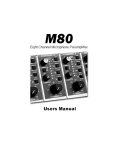
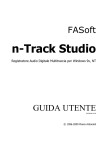
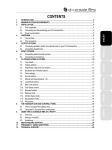
![[English] 1.05 MB](http://vs1.manualzilla.com/store/data/005996029_1-64e3e7fd30afe2bfde66bd2282cc28e3-150x150.png)
